|
Related FAQs: Marine Life
of the Tropical West Atlantic, Tropical West Atlantic 2,
Related Articles: TWA
Invertebrates, Algae, Vascular Plants, Introduction to Fishwatcher's Guide
Series Pieces/Sections, Lachnolaimus maxiumus/Hogfish, Hogfishes of the Genus
Bodianus,
The Tropical West Atlantic:
Bahamas to Brazil, Part 6
To: Part 1, Part 2, Part 3,
Part 4, Part
5, Part 7, Part 8, Part 9,
Part 10, Part
11,
|
|
| Bob Fenner |
|
Lizardfishes, Family Synodontidae. Found lurking
about on the bottom, or even scooting along with divers, hoping for a
distracted fish meal.
| Synodus intermedius (Spix & Agassiz
1829), the Sand Diver. To 46 cm., 1 kg maximum. Western Atlantic.
Most common lizardfish there. Typically found on the sand, near
boulders. One in Cancun, Mexico, and a profile of one off
Bonaire. |
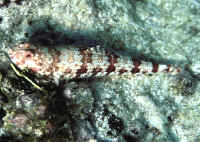 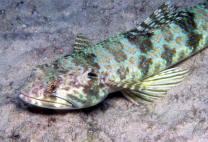
|
Pomacanthidae, Marine Angelfishes. All but one of the seven
species of pomacanthids found here are tough and all are valued as
aquarium specimens. The two dwarf or pygmy angels of the genus
Centropyge are highly desired. The Cherubfish, C. argi (1) and
Flameback Angelfish, C. aurontonota (1), stay small (3"
max.) 'but can hold their own with all types of marine life.
Ecotype: typically deep (80+') in and amongst heavy growths of
corals and gorgonians.
The "midsize" TWA member, the Rock Beauty, Holacanthus
tricolor (3), is the one "problem child" species that
frequently "gives up the ghost" mysteriously or stops
feeding. As with all angels, it's best to start with a small (few
inches in this case) specimen and train it on aquarium foods.
The remaining four true species of West Atlantic angels, attain a
good foot and a half in length, and therefore require large quarters.
Both the French, Pomacanthus paru (1), and Gray, P.
arcuatus (1), start off as gorgeous young, but the former remains a
striker with the Gray turning somber shades of its namesake. The Blue,
Holacanthus bermudensis (1), and Queen, H. ciliaris (1),
both start and finish good looking, the Queen retaining her
"crown" with age.
Ecotype: Definite territories on patch and contiguous reefs,
defended against similar appearing fishes.
| Centropyge argi Woods &
Kanazawa 1951, the Cherub or Atlantic (Caribbean) Pygmy Angel (1).
To 2.5" overall. Bermuda on down to the coast of Brazil.
Aquarium and a Cozumel, Mexico pix of more adult, more
juvenile individuals. |
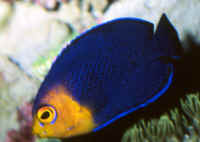
|
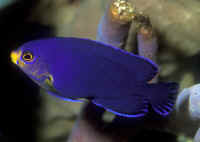
|
|
Centropyge aurantonotus Burgess 1974, the (
Brazilian) Flameback Angel (1) is very much like the more
northerly Centropyge argi with more orange color on its
back, at a much higher price. Found in southern part of the
Caribbean Sea. Note the dark blue caudal fin, distinguishing it
from C. acanthops. To 2.5" overall length. Pix
by Hiroyuki Tanaka and RMF.
|
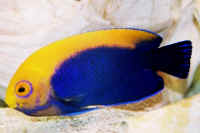 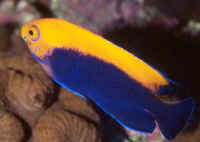
|
|
Holacanthus tricolor (Bloch
1795), the (Atlantic) Rock Beauty (3). The one
"stinker" in the bunch. Most specimens die
"mysteriously" from the effects of capture and lack of
nutrition... place yours in an established live rock tank, and
get it to feed immediately. To eight inches in length. Below:
Juvenile in aquarium, semi and full adult in the
Bahamas.
|
|
Holacanthus bermudensis
Goode 1876, the Blue Angelfish (1). Often confused price-wise
with the Queen Angelfish, whose juveniles have bent mid-body bars
and adults are much more colorful overall. Hybrids between the
two abound. Patchy distribution in the tropical west Atlantic. To
thirteen inches or so in length. Below: Juvenile and mid-size
adult in captivity, adult off of Florida shown.
|
|
Holacanthus
ciliaris (Linnaeus 1758), the Queen Angelfish (1).
A true queen of fishes. To seventeen inches in the wild. Florida
to Brazil in the tropical west Atlantic. Juvenile in captivity
and adult in the wild (Bahamas) shown.
|
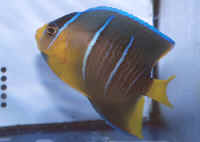 
|
|
Pomacanthus arcuatus Gray
1831, the Gray Angelfish (1). A beauty as a juvenile (shown).
Tropical west Atlantic, Bahamas to Brazil. To a foot and a half
in length, friendly and long-lived in captivity. Juvenile and
sub-adult in the wild.
|
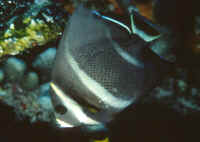 
|
|
Pomacanthus
paru (Bloch 1787), the French Angelfish (1). Another
standard in the aquarium trade. Beautiful and hardy, and large
(to fifteen inches in length and a foot tall). Tropical west
Atlantic from the Bahamas to Brazil. Pictured: a three inch
juvenile in captivity, foot long adult in Belize.
|
 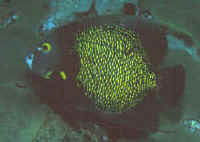
|
The Damselfishes, Family Pomacentridae. It's a shame that
due to the vagaries of economics and airline schedules that a few more
of the damsels of the TWA don't make it more into pet-fish markets.
Of the few that are regularly available the Yellowtail, Microspathodon
chrysurus (1), is a real giant, attaining some seven inches in length;
start with a smallish one.
Ecotype: The Sergeant Major and Blue Damsels tend to be mid water or
over reefs of mid to shallow depths. Other damsels mentioned occupy
rock-rubble and coral habitats.
Genus Abudefduf: The Sergeant Major, Abudefduf
saxatilis (1), used to be a standard in the trade a few decades
back. This is a sturdy, albeit black and silvery-white fish, with a
real gusto for swimming about; well worth the extra cost compared with
Pacific possibilities.
| Abudefduf saxatilis (Linnaeus 1758), the
Sergeant Major. Both Atlantic coasts to cooler waters. To six
inches in length. This one from the Bahamas. Very similar to the
Indo-west Pacific Abudefduf vaigensis, discerned by its
further back fourth black body bar. |

|
There are a few delightful Chromis from the region, and
it's a shame they're not available more often. I'd sell the
Blue Chromis, C. cyanea (1), Yellowtail Reeffish, C. enchrysurus (1),
Brown Chromis, C. multilineata (1), and Sunshinefish, C. insolata (1),
all day long. These are all hardy, stay somewhat colorful and only
moderately "mean".
| Chromis cyanea (Poey 1860), the
Blue Chromis. One of actually a few species with this common
appellation. This one hails from the tropical west Atlantic. To
four inches in length. One off the coast of Bimini and another off
Cancun. |
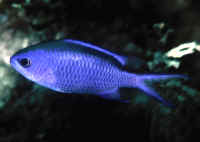 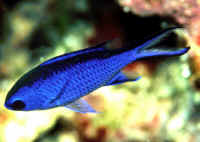
|
| Chromis multilineata (Guichenot 1853), the
Yellow-Edge Chromis. Tropical west Atlantic. To about four inches
maximum length. This is another unintentional catch Damsel offered
infrequently. One in St. Lucia, another off Bonaire where the
species is a common reef inhabitant. |
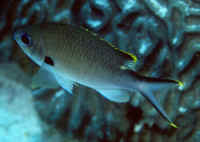 
|
| Chromis insolata (Cuvier 1830), the Olive
Chromis. An incidental Damsel shipped out of the tropical western
Atlantic from time to time. To about five inches maximum length. A
juvenile in Cozumel and adult one in the Bahamas. |
 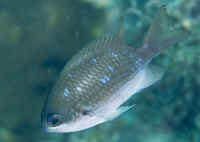
|
Genus Microspathodon:
| Microspathodon chrysurus (Cuvier 1830), the
Yellowtail Damselfish, Atlantic Jewel Damsel. Tropical west
Atlantic. To six inches in length. Shown are a juvenile (about
1") with a clear caudal fin, an intermediate (2"), and
adult (four inch) specimen in the Bahamas. |
The genus Stegastes (2) is another matter. Folks do sell good
numbers of juvenile Beau Gregorys, S. leucostictus, and a few
(but growing) number of Cocoa Damsels, S. variabilis, Threespot
Damsels (Atlantic), S. planifrons, and Bicolors, S.
partitus as good-looking juveniles. But all except the latter
become dull brownish with age, and they are MEAN; territorial to the
nth degree.
| Stegastes diencaeus (Jordan & Rutter
1897), the Longfin Damsel. Tropical west Atlantic. To five inches
in length. Occasionally imported and sold as juveniles. Adults an
overall brown with dark margins on all scales. Juveniles in the
Bahamas and St. Thomas. |
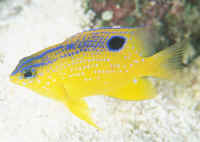 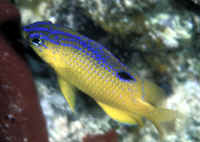
|
| Stegastes fuscus (Cuvier 1830), the Dusky or
Brazilian Damselfish. Tropical West Atlantic (and eastern, off
Senegal). To five inches in length. Feeds on benthic algae,
hydroids, algae, copepods by day. Adult off of Cozumel. |

|
| Stegastes partitus (Poey 1868), the Bicolor
Damselfish. Tropical west Atlantic. To two and a half inches in
length. Occasionally imported for our use. Not tremendously
beautiful looks-wise, but an interesting aquarium species just the
same. St. Lucia and Cancun photographs. |
 
|
| Stegastes planifrons (Cuvier 1830), the
Three-Spot (Atlantic) Damsel. Tropical west Atlantic. To three and
a half inches overall length. Juveniles, with their bright yellow
bodies and bold black body spots are occasionally caught for
aquarium use... ultimately turning into bland brown behemoths.
Juvenile and sub-adult in the Bahamas. Full size one that bit
me in Cozumel. |
| Stegastes variabilis (Castelnau 1855), the
Cocoa Damselfish. Tropical west Atlantic. To three inches long.
Similar to Beaubrummel, but juveniles bear a distinct black ocellus
after their dorsal fins. Adults yellowish below, grading to brown
above. Juv. and adult images taken in the Bahamas. |
 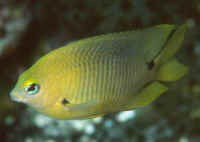
|
To: Part 1, Part
2, Part 3, Part
4, Part 5, Part
7, Part 8, Part
9, Part 10, Part
11,

